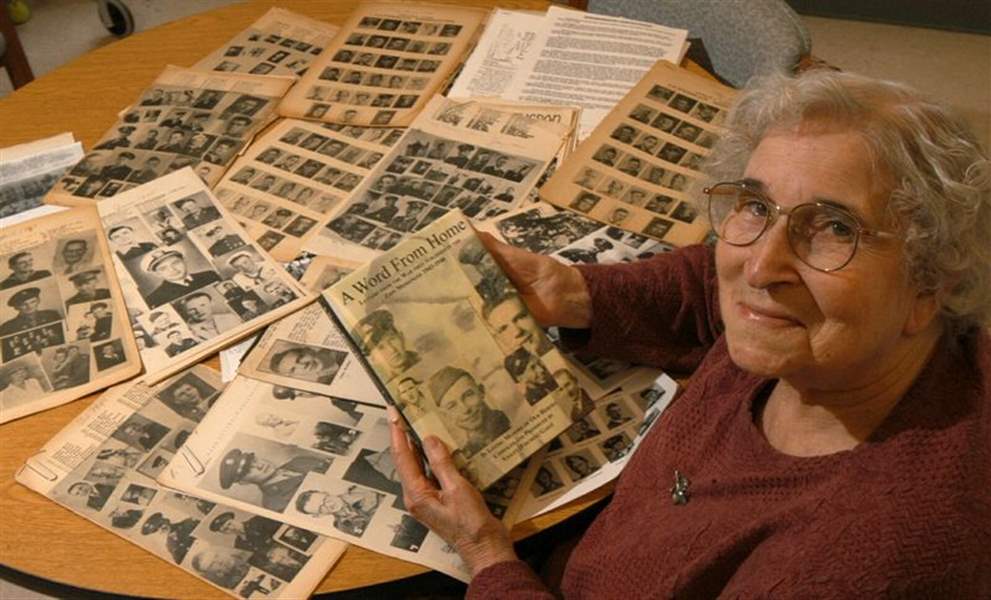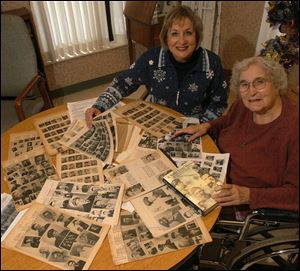
Yellowing papers turn into slices of history
1/18/2004
'This is history,' says Violet Gaige, with her new book and yellowed copies of the newsletter.
long / blade

'This is history,' says Violet Gaige, with her new book and yellowed copies of the newsletter.
The joke goes like this: A little girl walks into the drugstore and says, “I want some liniment and cement.” The puzzled druggist says, “Liniment and cement? Are you going to use them at the same time?” The youngster replies, “Yes, sir. Ma hit Pa with the pitcher.”
Maybe the corny humor doesn't travel so well through time. But in August, 1943, it flew on mimeographed wings from rural Ottawa Lake, Mich., to kids in barracks and tents, foxholes and trenches sometimes half a world away.
They wrote back, too. And now hundreds of letters that appeared in wartime newsletter put out by the Luther League of Ottawa Lake's Zion Lutheran Church from 1943-46 have been reprinted in a book, A Word From Home (Quiet Storm Publishing). The letters were culled from papers saved for nearly 60 years by the woman who served as the Zion Lutheran Messenger's editor-in-chief.
“This is history. I wanted to do it for these people,” said 88-year-old Violet Gaige, tapping the book with a crooked forefinger. “My brothers and especially those nine men [from the newsletter's mailing list] who gave their lives.”
The nine men, who are pictured on the book's cover, included four who were members of the Zion Lutheran congregation.
Mrs. Gaige now lives in Lutheran Village at Wolf Creek in suburban Holland.
She was 28-year-old Violet Fischer when she started the newsletter, earning the editor's post by virtue of suggesting that church members undertake the project.
“I wanted them to know what was going on back there,” explained Mrs. Gaige. Some of the teens and twentysomethings from the heartland were at bases in the states; some were stationed in places they could identify to the folks back home only as "somewhere” in the Pacific, “somewhere” in Italy.
Some were in countries they may not have known existed before they found themselves there — Burma, New Guinea, Trinidad. Others were deployed in places they probably didn't expect to visit so soon — England, Ireland, the Hawaiian islands.
The first draft from Monroe County had come in February, 1941. As members of the congregation were called up, the Luther League young people's group gave each a farewell party and a Bible. They followed up with church bulletins, cards, and letters, but Violet wanted to do more. She had a special interest and concern: Her brother Pete had been drafted in June, 1941, and two more of her brothers followed him into the service.
They were among more than two dozen men and one Army nurse from Zion Lutheran who served in World War II. But at its peak, the newsletter went to 170 service men and women in addition to hundreds of civilians, Mrs. Gaige said. Military readership grew as recipients shared their issues with buddies and left copies behind in USOs, where they were picked up and read by strangers who then asked to be added to the mailing list.
“Anyone who wanted the paper could be put on the mailing list,” she said. “We had a British soldier and a young man from Wisconsin.”
Money wasn't a concern. “Everything was a donation. The money was always there,” she recalled.
An excerpt from the August, 1943, issue published in her book describes the newsletter assembly line: Three leaves were added to the dining room table in the Fischer home to accommodate three typists and Violet, who cut the stencils. At a nearby card table, two more volunteers drew the cover page. In the living room, a crew of five ran the mimeograph machine. Three more people, "the decoration crew," colored figures and letters on the first page.
Readers devoured a newsy stew of marriages and births, illnesses and deaths, baptisms and golden wedding anniversaries. There was a devotion from the pastor, letters from service men and women, and their addresses.

Violet Gaige, right, and her daughter Jan Baker of Perrysburge. 'My mother has always had the dream of writing her own book,' Ms. Baker says. 'We're just ecstatic for her.'
One of the benefits of sharing the war-zone addresses was that the faraway service men and women could look each other up, Mrs. Gaige pointed out. In a letter printed in the September, 1944, issue, for example, her brother Pete reported that he had tracked down a friend from home who was assigned to a nearby unit in New Guinea.
"We really had a swell visit and I helped him dig his foxhole," Pete wrote.
The first issue of the newletter came out in March, 1943; the last was dated September/October, 1946.
"We started with 100 copies and within three or four months went up to 300," Mrs. Gaige said. "We were up to 500 in the fall of 1945."
It was a big job, piled atop the hours she spent working at the dime store in Sylvania. "When the war was over, my mind was tired," she admitted.
Afterward, Mrs. Gaige packed up copies of every issue and went on with her life, becoming a wife, mother, grandmother.
Four years ago this month, she began going through the boxes of yellowed papers with fading text and photos. She wanted to read all 269 pages of the newsletter, start to finish.
As she read and remembered, "two of my nurses said, 'You've got to put this into a book,' " Mrs. Gaige said.
She agreed and did her own version of the military draft, enlisting friends and family members to help with the project.
"My mother has always had the dream of writing her own book," said Jan Baker of Perrysburg, Mrs. Gaige's daughter. "We're just ecstatic for her."
The hard-cover, 395-page book is available by ordering directly from Mrs. Gaige, or online from www.quietstormpublishing.com, headed by Mrs. Gaige's grandson, Clint Gaige. The cover price is $35; signed copies from Mrs. Gaige are $40, which includes the cost of shipping and handling.
The family is hoping to sell the book in local stores as well.
The Rev. Everett Arnold, chaplain at Lutheran Village at Wolf Creek, drew from several letters in the book for his Thanksgiving message last year.
"I was impressed with the honest recognition of how tough times can be, but always this resounding resurgence of gratitude. They would tell how bad it was, but the letter would come back to what I am thankful for," Mr. Arnold said. "No matter how tough it got, their thankfulness couldn't be wiped out.
"I thought it was a good message for our times."